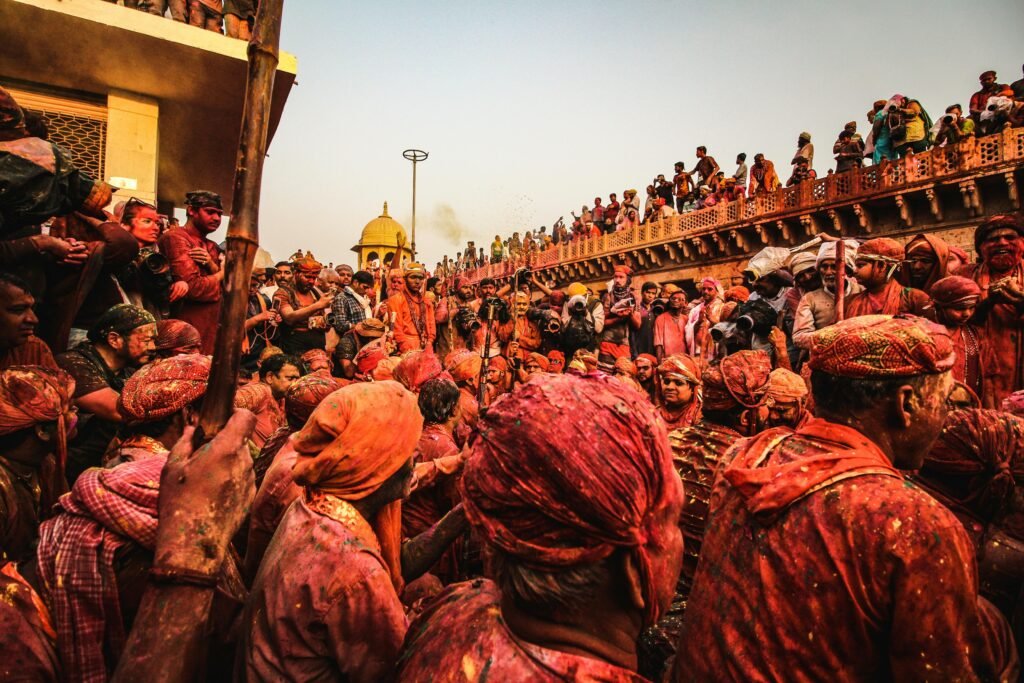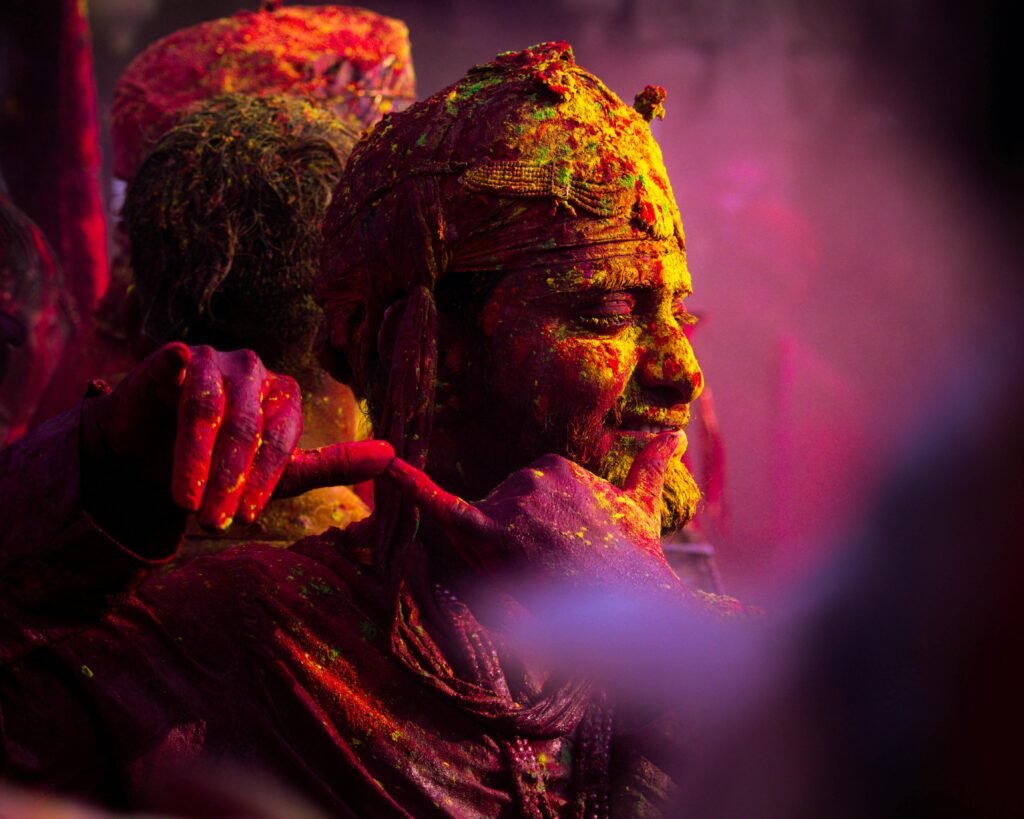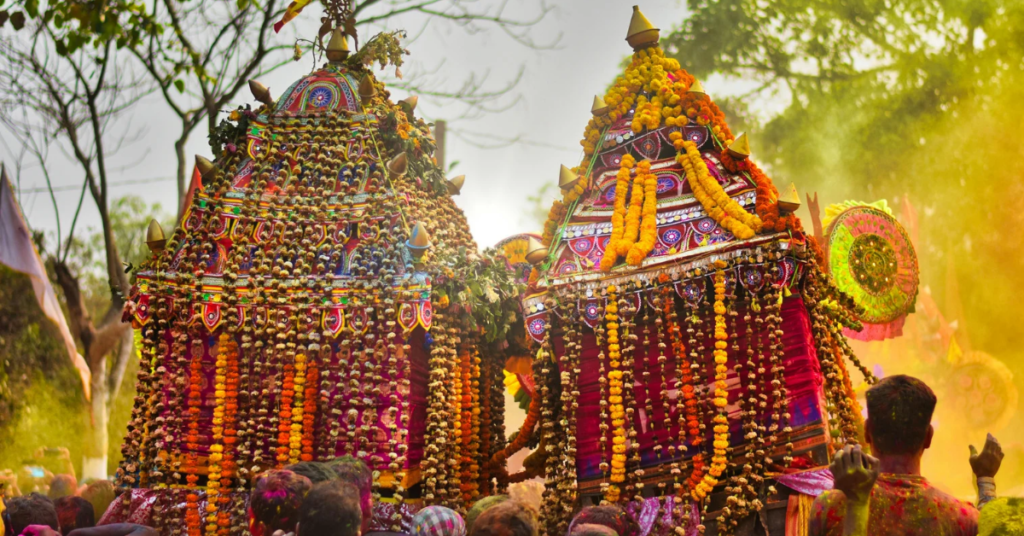
Introduction: The Magic of Temple Festivals
Temple festivals in India are vibrant celebrations of devotion, culture, and tradition. A temple festivals travel guide helps you explore these sacred events filled with rituals, music, and community spirit. These festivals, often dedicated to deities like Lord Shiva, Vishnu, or Devi, offer a glimpse into centuries-old traditions. Legends such as Lord Krishna’s Raas Leela during Holi or the grand Rath Yatra of Lord Jagannath draw millions of devotees annually.
What makes these festivals truly magical is the spiritual energy they exude. Whether it’s the rhythmic beats of drums during Kerala’s Thrissur Pooram or the soulful bhajans during Varanasi’s Ganga Aarti, every moment feels divine. You don’t just witness a festival — you become part of an ancient story unfolding before your eyes.
Planning a temple visit during these festivals transforms your travel experience. You get to witness vibrant processions, intricate rituals, and the devotion of thousands gathered to seek blessings. For example, Kumbh Mela, the largest spiritual gathering globally, attracts over 100 million devotees, creating an unparalleled atmosphere of faith.
When you plan your visit well, you can avoid the crowd, enjoy peaceful darshans, and participate in special poojas. Visiting temples during festivals also offers a chance to experience local culture, taste authentic prasad, and witness ancient rituals up close. With a thoughtful approach, your temple festival journey becomes not just a visit but a deeply enriching spiritual experience.
Understanding Major Temple Festivals
India’s temple festivals are a vibrant blend of devotion, tradition, and celebration. A temple festivals travel guide introduces you to the most popular and spiritually enriching festivals across the country. Each festival, steeped in mythology and faith, draws millions of devotees eager to seek divine blessings and witness ancient rituals.
1. Kumbh Mela – The Largest Spiritual Gathering
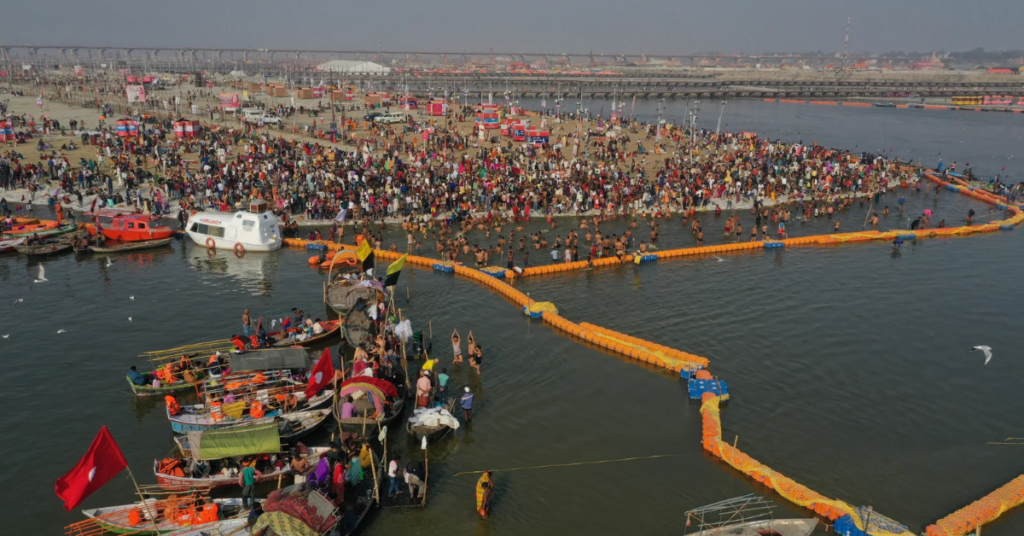
Kumbh Mela, held every 12 years, is the world’s largest spiritual gathering. Devotees gather at four sacred riverbanks – Prayagraj, Haridwar, Nashik, and Ujjain – to take a holy dip. The festival, believed to cleanse sins and grant moksha, attracts over 100 million devotees. According to legend, drops of Amrit (nectar of immortality) fell at these locations, making them eternally sacred.
2. Jagannath Rath Yatra – The Grand Chariot Festival
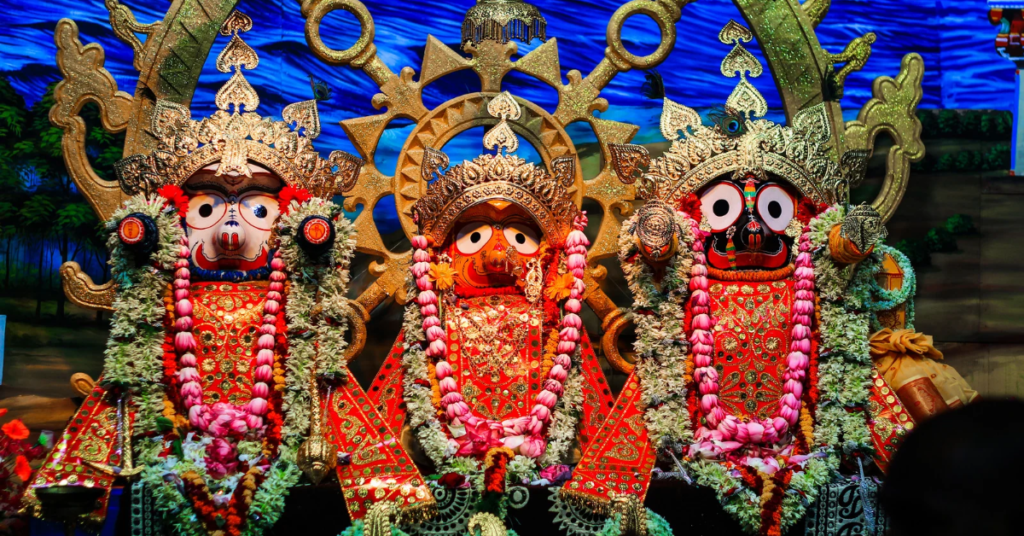
Jagannath Rath Yatra in Puri, Odisha, is a spectacular event where Lord Jagannath, Balabhadra, and Subhadra are taken on grand chariots. Thousands of devotees pull these chariots, believing that even touching the ropes washes away sins. The atmosphere is charged with chants of “Jai Jagannath,” and the festival attracts over a million devotees each year.
3. Meenakshi Temple Thirukalyanam – A Divine Wedding
The Thirukalyanam festival at the Meenakshi Amman Temple in Madurai celebrates the celestial wedding of Goddess Meenakshi and Lord Sundareswarar (Shiva). The grand procession, vibrant decorations, and devotional music create an aura of divine bliss. Devotees believe attending this festival blesses them with marital harmony and happiness.
4. Diwali Temple Celebrations – Triumph of Light
Diwali, celebrated across India, transforms temples into dazzling hubs of devotion and joy. Special aartis, bhajans, and prasad mark the festival, celebrating Lord Rama’s return to Ayodhya after defeating Ravana. Temples glow with thousands of diyas, and the festive energy draws crowds eager to seek blessings for prosperity.
5. Navratri Festival – Nine Nights of Devotion

Navratri honors Goddess Durga’s victory over Mahishasura, symbolizing the triumph of good over evil. Temples hold elaborate poojas, garba dances, and recitals of Devi Mahatmya. Devotees flock to temples during these nine days to seek blessings and immerse themselves in the divine energy.
6. Mahashivratri – The Night of Lord Shiva
Mahashivratri, dedicated to Lord Shiva, is a night of fasting, prayers, and meditation. According to legend, Lord Shiva performed the cosmic dance of creation and destruction on this night. Temples like Kashi Vishwanath and Somnath witness an influx of devotees staying awake through the night, chanting “Om Namah Shivaya.”
Read the blog article, to learn more about Best Temple Festivities. Experience the Best Temple Festivities with Vibrant Celebrations
Why Festival Time Draws Larger Crowds
Temple festivals create a unique spiritual atmosphere where faith, culture, and celebration blend seamlessly. The allure of divine blessings, sacred rituals, and vibrant traditions attracts devotees in large numbers. Many believe visiting temples during festivals grants special boons and fulfills wishes.
Festivals also offer a chance to witness rare rituals and cultural performances. Whether it’s watching priests perform the Ganga Aarti during Kumbh Mela or witnessing the grandeur of Jagannath Rath Yatra, these moments leave a lasting impression. This magical combination of devotion and festivity explains why festival time draws massive crowds year after year.
A well-planned visit during these festivals ensures a deeply rewarding spiritual experience. Following a temple festivals travel guide helps you navigate these celebrations with ease, allowing you to soak in the divine energy while avoiding unnecessary stress.
Best Time to Plan Your Visit
Timing is everything when it comes to visiting temples during major festivals. A temple festivals travel guide can help you choose the best time to avoid crowds and enjoy a peaceful darshan. Arriving a day or two before the festival peaks gives you a chance to witness the preparations and experience the spiritual buildup. Early arrivals also let you participate in preliminary rituals, which are often less crowded yet equally significant.

For a smoother experience, consider visiting the temple early in the morning or late in the evening. Early mornings, especially during Brahma Muhurta (4 AM to 6 AM), are considered highly auspicious in Hindu tradition. Devotees believe that offering prayers during this period brings divine blessings. Late evenings, just before temple closure, are also ideal for a quieter and more serene darshan.
Weekdays are your best bet if you want to avoid the weekend rush. Festivals often attract larger crowds on weekends as families and tourists flock to temples. Visiting on weekdays ensures you can soak in the spiritual ambiance without feeling overwhelmed. For instance, visiting the Tirupati Balaji Temple on a weekday drastically reduces your waiting time compared to weekends.
Planning your visit wisely not only enhances your spiritual journey but also allows you to participate in rituals peacefully. Following a temple festivals travel guide ensures you enjoy a fulfilling experience without the hassle of navigating through massive crowds.
Advance Booking of Accommodation and Travel
Booking your stay and travel well in advance is a must during major temple festivals. A temple festivals travel guide recommends securing accommodation at least 2-3 months ahead. Popular temple destinations like Tirupati, Puri, and Varanasi witness a massive influx of devotees during festivals. Rooms fill up quickly, and last-minute bookings can be expensive and stressful.
Nearby stay options often include dharamshalas, budget lodges, and guesthouses managed by temple trusts. For example, the Tirumala Tirupati Devasthanams (TTD) offers affordable and clean accommodations for devotees. Opting for such stays ensures proximity to the temple and a spiritually immersive experience.
If you’re looking for affordable stays, explore homestays or budget hotels on trusted platforms. Booking well in advance not only saves money but also ensures you stay close to the temple, making your spiritual journey seamless and stress-free.
Avoiding the Crowds: Insider Tips
Crowds are an unavoidable part of major temple festivals, but a temple festivals travel guide can help you manage them smartly. Avoid visiting during peak hours, usually mid-morning and evening, when the crowd surges. Festival peak days, especially weekends and final ritual days, witness the highest footfall.
Arriving early in the morning, around 4-6 AM, ensures a serene and peaceful darshan. According to Hindu belief, Brahma Muhurta is the most auspicious time for prayers and meditation. Late evening visits, just before temple closing, also offer quieter moments and fewer crowds.
For better viewing spots, position yourself near the main sanctum early. During Rath Yatras or processions, staying ahead of the procession route guarantees a prime view. Seek VIP darshan passes, if available, for faster and smoother access.
If large crowds overwhelm you, consider exploring alternative viewing locations. For instance, Puri’s Jagannath Rath Yatra can be enjoyed from quieter streets or balconies along the route. Similarly, Kumbh Mela offers various ghats with fewer devotees, providing a calm experience.
Staying patient and maintaining calm helps manage crowds effectively. A well-planned temple festivals travel guide ensures a rewarding experience, allowing you to witness the divine without feeling overwhelmed.
Cultural Etiquette and Preparation
Following cultural etiquette enhances your experience during temple festivals. A temple festivals travel guide recommends wearing modest clothing. Traditional attire like sarees, salwar kameez, or dhotis is ideal. Covering your head with a scarf or dupatta shows respect, especially in North Indian temples.
Respectful behavior is essential inside temples. Maintain silence near the sanctum and avoid pointing feet toward the deity. Legends suggest that Lord Vishnu blesses those who maintain humility and devotion.
Always check photography permissions before clicking pictures. Many temples prohibit photography inside the sanctum to preserve spiritual sanctity.
Carry essentials like water, a small mat for sitting, and some prasad to offer. Expect long queues, vibrant processions, and an atmosphere filled with devotion and chants.
Being prepared ensures a fulfilling and respectful experience. Following a temple festivals travel guide allows you to blend seamlessly into the spiritual ambiance.
Exploring Online Services
Online services make temple visits easier during festivals. A temple festivals travel guide recommends booking poojas and darshan online to avoid long queues. Many temples offer e-pooja services, allowing devotees to perform rituals from home.
Popular platforms like the Divyakripa app provide virtual darshan, e-donations, and prasad delivery. Temples such as Tirupati Balaji and Shirdi Sai Baba offer these services, ensuring a hassle-free experience.
E-donations help maintain temple operations while allowing devotees to contribute conveniently. Using online services through apps like Divyakripa enhances your spiritual journey without the stress of waiting in long lines.
Understanding Local Transport and Routes
Navigating temple towns becomes easier with a temple festivals travel guide. Local transport options like buses, autos, and cycle rickshaws are affordable and easily available. Many devotees prefer using shared autos, especially during crowded festivals, to reach temple premises quickly.
For major temples like Tirupati and Vaishno Devi, pre-booked shuttle services help reduce travel hassles. Parking near popular temples can be tricky, so opt for designated parking lots to avoid fines.
Using apps like Google Maps gives real-time traffic updates, helping you choose the fastest route. A well-planned route saves time and enhances your spiritual journey.
Conclusion
A well-planned visit to major temple festivals offers a deeply enriching spiritual experience. Participating in key rituals and special poojas connects you with divine blessings. According to Hindu tradition, attending the Mangala Aarti at Kashi Vishwanath or the Abhishekam at Tirupati Balaji brings immense spiritual merit.
Exploring local culture, tasting prasad, and understanding age-old traditions add charm to your journey. Temples often offer unique prasad, like the famous Tirupati laddus or Puri’s Mahaprasad, believed to be blessed by the deity.
Take time to meditate or reflect after darshan for a deeper spiritual connection. Many devotees prefer spending quiet moments near the sanctum, soaking in the divine energy.
A temple festivals travel guide recommends booking accommodations and travel early, exploring online services like Divyakripa for virtual darshan, and avoiding peak crowds. Planning mindfully ensures a smooth and fulfilling visit.
Participating with devotion and respect transforms your temple visit into a soul-enriching journey. Early planning, patience, and mindful participation enhance your connection with the divine, leaving lasting memories of faith and devotion.

